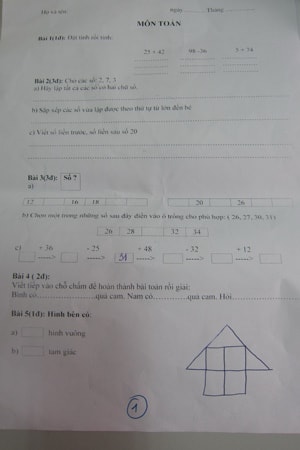First grader with blurred vision studying for semester exam on April 30th holiday
Many parents of first graders were “shocked” by the series of review exercises that teachers assigned to their children during this time. The April 30 and May 1 holidays for many families are at risk of turning into a review period to prepare for the semester exams, ending the first school year of their children.
 |
| A homework sheet |
What is "struggle" mom?
Ms. Huong Giang (Hai Ba Trung, Hanoi) shared her frustration when guiding her child to do the review test. “Oh my god, the student is only 7 years old, but the fill-in-the-blank exercise is full of words that they don’t know the meaning of, so they can’t fill in. I gave the rhymes “uông” and “ươn” and asked the child to fill in the correct word “bươn chay”. My child sat there, not knowing what to fill in the given phrase “B… chay” – all he knew was… a toothbrush. When I asked him to fill in the rhyme “ươn” to make the word “bươn chay”, he was stunned again and asked “What is bươn chay, Mom?”
“Using a dictionary still doesn’t help my child understand what “bươn chay” means. I have to teach my child that when he comes across these types of exercises and doesn’t understand the meaning of the word, he should try to combine the given rhymes with the given consonants, then combine the marks (also given), and when he reads out loud, fill in whichever word he feels is comfortable.”
But not all the time do children have the opportunity to apply the groping method that Ms. Giang teaches, because some fill-in-the-blank exercises are even more difficult.
There is a lesson called “Fill in the words with the rhyme “en” or “oen”, in which there is the sentence “The baby cried, wet eyes…”. My child is stumped. I know that in this case, I can only fill in the word “nhoèn”. But after listening, my child still asks, “What is ‘nhoèn’?” and “Wet nhoèn”? When I look it up in the dictionary, it all comes up as “nhoèn (eyes) wet, sticky with lots of pus”, “nhoèn dụ, toét nhoèn”… My child understands the explanation, but clearly this sentence is not very interesting.
Ms. Thu Ha also "showed off" her son's first grade review paper at a primary school in Cau Giay district, Hanoi, with the question: "Fill in "wish" or "wet" with the given sentences:
-……………. flow to low places.
-Good harvest ……………, hope for next season.
-……….. like a drowned rat.
-V…………….. through the challenge”.
“One word doesn't have a consonant in front, but 2/4 words have to be filled in without a consonant in front. The meaning is unknown, so the children can guess freely, and sometimes they won't know how to guess,” Ms. Ha concluded.
There is also a spelling exercise that is equally difficult to understand. “My child was assigned to write a paragraph, I read it, he copied it, but there was a sentence that even though he copied it correctly, I still wondered why we teach our children like this. For example, the sentence “After Hai Ba Trung two hundred years, then Lady Trieu and the people…” I don’t know what the writer of this sentence intended to say, after Hai Ba Trung was after when, after birth or after death, after the uprising…?”. This is the concern of Ms. Ngoc Anh (Ba Dinh, Hanoi).
Green face because of math homework
 |
| The joy of the first day of school - Van Chung |
Since the middle of last week, every day his son has brought home a math homework sheet assigned by his teacher. Mr. Manh Hung (Tu Liem, Hanoi) lamented that he used to study natural sciences but sometimes he did not know how to explain to his son, or he was confused because he himself did not understand why his son had to learn such difficult lessons.
Or even posts that don't make any sense.
For example, the exercise “Given the numbers 2, 7, 3. a) Make two-digit numbers. b) Arrange the numbers just made in order from largest to smallest. c) Write the number before and after 20”.
“With such a topic, the first two questions were fine, but the question in part c fell flat). The number before 20 is 19, the number after 20 is 21, clearly unrelated to the three numbers 2, 7, 3 given in the first part. Any student who followed the topic closely might not be able to do it” - commented Mr. Hung.
But the question that made Mr. Hung feel sorry for his son was a math problem with 5 consecutive calculations of addition, subtraction, and finding numbers to fill in the blanks.
Ms. Thu Trang (Hoan Kiem, Hanoi) "contributed" a math problem that both parents spent the whole evening explaining to their child, but the child was still confused: Given the numbers 1 2 3 5 6 7, fill in the blanks so that when adding the numbers on the sides of an equilateral triangle, the result is 10.
“She gave me 7 math test papers to take home to practice from now until the semester exam after the April 30 holiday. One test paper has 5 questions, each question has at least 2 parts, and each part is all about addition and subtraction, she said the requirement is to do it within 1 hour. Just kidding, but if the kids can manage it, our country will have a lot of Ngo Bao Chaus in the future” - Ms. Trang humorously said.
According to vietnamnet
